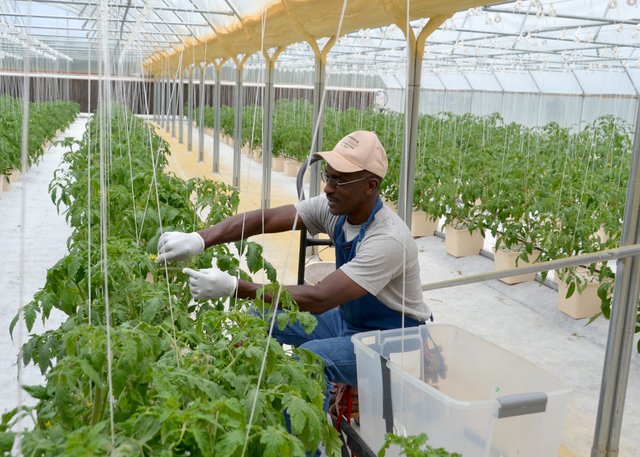HOW TECHNOLOGY HAS HELPED IMPROVE THE AGRICULTURAL SECTOR
Agriculture has come a long way over the years. There are many benefits it has gained from developing technologies over time.
Technology has played a major role in developing the agricultural industry. Today it is a possibility to grow crops in a desert by use of agricultural biotechnology. What this technology has done is that plants have been engineered to survive in drought conditions. Through genetic engineering, scientists have managed to introduce traits into existing genes that will make crops resistant to droughts and pests.

Source: https://goo.gl/images/pC4Vxa
There are many innovations in the mobile/IT and energy spaces that have the potential to make a huge and lasting impact on the farm. An example is, smart power systems, precision agriculture tools, farm management software, and affordable sensors are not all that within the reach of even the smallest farmers today in Nigeria. The impact of technology in agriculture and its wide acceptance, entrepreneurs are taking advantage of new technology that makes certain products possible. Such as in clean technology advances from ambient energy, to waste-to-energy, to renewable sources from agricultural wastes.
Technology has been applied in an endless list of agricultural processes that have great results. Including farm machinery, livestock handing facilities, feeding capabilities, agronomy, communication others. Below are a few ways in which technology has evolved within agricultural industries across bothers.
IN THE 1960s:
The Green Revolution Era
In the mid-1940s the U.S. Vice President Henry Wallace spearheaded a program to help developing nations around the world feed their growing populations. The program included four scientists, one of whom was Dr. Norman Borlaug.
The scientist (Borlaug) started a growing process that allowed plants to thrive with new irrigation and crop management techniques to help inctease crop yield. By the 1960s, the benefits of what was nicknamed the “Green Revolution” at the time were apparent when successful new wheat varieties were made available in countries across the globe.
IN 1974
Roundup agricultural herbicide released
Monsanto developed a new herbicide using glyphosate as the active ingredient. Glyphosate-based herbicide is used by farmers today to control weeds in their crops. Roundup also made its way into lawn and garden products, which allow landowners to kill weeds along sidewalks, driveways, gardens, and fences.
IN 1975
Rotary combines are introduced
IN 1975, the first twin-rotor system combine was created by Sperry-New Holland. This allowed the crop to be cut and separated in one pass over the field. For corn, it not only separated the husk and ears, but shelled the kernels, and chopped the stalks as well.
.jpg)
Source: 
IN 1982
*First genetically modified plant cell
There were scientists working at Monsanto Company who became the first in the world to genetically modify a plant cell. The team used Agrobacterium to introduce a new gene into the petunia plant and announced their achievement the following year. Five years later, Monsanto researchers planted their first outdoor trials of a genetically modified crop – tomatoes that were resistant to Roundup agricultural herbicide, insects, or viruses. The Agrobacterium method first used in 1982 is still in use today by Monsanto scientists and by other companies’ scientists.
IN1994
Satellite technology advances farming
History was made for the first time , farmers were able to use satellite technology to see their farms from overhead, allowing for better tracking and planning for planting and animal grazing.
IN 1996
Monsanto’s first GMO crops become commercially available
Monsanto introduced Roundup Ready® soybeans and Bollgard® insect-protected cotton, the first GMO row crops available for purchase to farmers. The soybeans provided tolerance to Roundup agricultural herbicide. The GMO traits in cotton provided protection against the cotton bollworm, tobacco budworm, and pink bollworm.

Source: https://goo.gl/images/wMZVvW

Source: https://goo.gl/images/YxHCn1
IN THE 2000s
Software and mobile devices helps farmers have better harvests
Like many people around the world, farmers started carrying mobile devices, which allowed them to stay connected to colleagues while in the field. Chat groups were formed to assist members of the group. This also meant they now had access to data needed while on-the-go, including the ability to place orders for seed or fertilizer at any time or in any place. A typical example is @farms using the blockchain technology to eradicate poverty and increase food production.
.jpg)
Source: https://goo.gl/images/Au3QcM
IN 2015
Data revolutionizes farming potential
Farmers generally make decisions based on the information they have on-hand or available to them, which is why data has helped them harness the power of information to make better-informed decisions that allow them to use resources more sustainablyand well distributed. The Climate Corporation’s Climate FieldView™ is a digital platform that brings together data collection, agronomic modeling, and local weather monitoring, which gives farmers a better understanding of their fields. These tools allow farmers to plan for better harvests and make decisions that are better for the planet as well.
.jpg)
Thank you for reading.
I am @gloeze

Great piece!
Indeed technology has made agriculture better, much more easier and more productive. But Nigeria has not fully adopted technological agriculture,most of our farms still use the manual method.
These technologies are expensive when you consider the fact that we are not the creators. It requires government support to input and create the enabling environment . However, what is most important is for the youth to embrace technological inclusiveness to learn and to create so as to subsidize what it would have costed if imported.